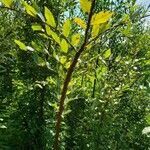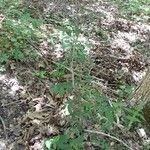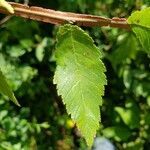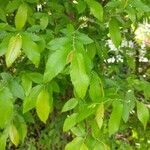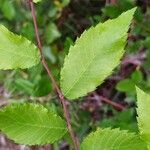A tree. It has a short trunk. The crown is open and rounded. It grows 12-24 m high. The trunk can be 50 cm across. The bark is light brown and thin with irregular cracks. The leaves are in 2 rows. They are 3-6 cm long. They are narrowly oval and often slightly curved. The sides are unequal and there are double teeth along the edge. The mid vein is yellow. There are many straight side veins. The leaves are thick and firm. They are dark green above and have soft hairs underneath. They turn yellow in autumn. The flowers are 3 mm wide and green. They are clustered along the twigs. The fruit are 10 mm long and flat and reddish. They have 1 seed. They have narrow wings with 2 curved points at the tip.
Tree to 15 m, the thinly hairy twigs commonly developing 2 opposite plates of cork, beginning the first or second season; buds glabrous or finely pubescent; lvs oblong or somewhat obovate, mostly 4–7 cm, less than half as wide, scarcely cordate at base, glabrous to scabrellous above; fls in short racemes seldom 1 cm; fr narrowly ovate, 1 cm incl. the 2 mm stipe, ciliate, pubescent on the sides; 2n=28. Moist or dry uplands; se. Va. to s. Ind., s. Ill., and Mo., s. to Fla. and Tex.
